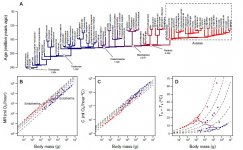Fred Ruhe
Well-known member

Enrico L. Rezende, Leonardo D. Bacigalupe, Roberto F. Nespolo & Francisco Bozinovic, 2020
Shrinking dinosaurs and the evolution of endothermy in birds
Science Advances. 6 (1): eaaw4486
doi:10.1126/sciadv.aaw4486
Abstract: https://advances.sciencemag.org/content/6/1/eaaw4486
The evolution of endothermy represents a major transition in vertebrate history, yet how and why endothermy evolved in birds and mammals remains controversial. Here, we combine a heat transfer model with theropod body size data to reconstruct the evolution of metabolic rates along the bird stem lineage. Results suggest that a reduction in size constitutes the path of least resistance for endothermy to evolve, maximizing thermal niche expansion while obviating the costs of elevated energy requirements. In this scenario, metabolism would have increased with the miniaturization observed in the Early-Middle Jurassic (~180 to 170 million years ago), resulting in a gradient of metabolic levels in the theropod phylogeny. Whereas basal theropods would exhibit lower metabolic rates, more recent nonavian lineages were likely decent thermoregulators with elevated metabolism. These analyses provide a tentative temporal sequence of the key evolutionary transitions that resulted in the emergence of small, endothermic, feathered flying dinosaurs.
Free pdf:
https://advances.sciencemag.org/content/6/1/eaaw4486/tab-pdf
Enjoy,
Fred
Shrinking dinosaurs and the evolution of endothermy in birds
Science Advances. 6 (1): eaaw4486
doi:10.1126/sciadv.aaw4486
Abstract: https://advances.sciencemag.org/content/6/1/eaaw4486
The evolution of endothermy represents a major transition in vertebrate history, yet how and why endothermy evolved in birds and mammals remains controversial. Here, we combine a heat transfer model with theropod body size data to reconstruct the evolution of metabolic rates along the bird stem lineage. Results suggest that a reduction in size constitutes the path of least resistance for endothermy to evolve, maximizing thermal niche expansion while obviating the costs of elevated energy requirements. In this scenario, metabolism would have increased with the miniaturization observed in the Early-Middle Jurassic (~180 to 170 million years ago), resulting in a gradient of metabolic levels in the theropod phylogeny. Whereas basal theropods would exhibit lower metabolic rates, more recent nonavian lineages were likely decent thermoregulators with elevated metabolism. These analyses provide a tentative temporal sequence of the key evolutionary transitions that resulted in the emergence of small, endothermic, feathered flying dinosaurs.
Free pdf:
https://advances.sciencemag.org/content/6/1/eaaw4486/tab-pdf
Enjoy,
Fred




